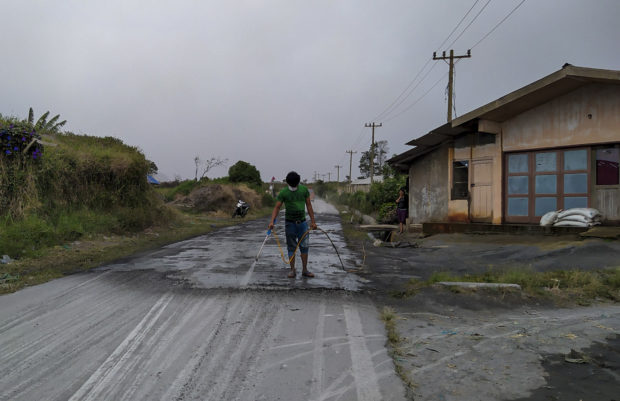Indonesia’s Mount Sinabung erupts again after year of inactivity

A resident of Sigarang-garang village in Karo regency, North Sulawesi cleans the road of volcanic ash spewed by Mount Sinabung on Aug. 8. The volcano erupted at 1:58 a.m., spewing ash 2,000 meters into the air. The ash covered residents’ houses and plantations. Antara/Sastrawan Ginting via The Jakarta Post/Asia News Network
JAKARTA — After being inactive for more than a year, Mount Sinabung in Karo regency, North Sumatra erupted early on Saturday morning, spewing ash 2,000 meters into the air.
The volcanic ash reached Berastagi, which is located around 30 kilometers from the volcano.
Muhammad Nurul Asrori of the Sinabung observation post said the volcano began erupting at 1:58 a.m. and continued for one hour. He advised local residents and tourists to stay outside a 3-km radius from the mountain top.
“We need to stay cautious because Mt. Sinabung’s status is still at level III, Siaga [Alert],” Nurul said.
There were no casualties in the eruption, but several local residents living around the volcano were shocked by the event. The ash covered the residents’ plantation and killed crops.
Article continues after this advertisementA villager of Naman Teran, Pelin Depari, said residents living 5 km from the volcano could hear the mountain rumbling, although they could not see the eruption directly because Sinabung was covered by fog.
Article continues after this advertisement“It is traumatic because it has been a year since the last time Mt. Sinabung erupted,” said Pelin on Saturday.
He added villagers were now cleaning their houses and fields of the volcanic ash.
Karo Disaster Mitigation Agency (BPBD) acting chairman Natanael Perangin-angin said the last time Sinabung erupted was in June 2019. “We thought we were safe. I hope there won’t be another eruption.”
He added that at least four districts were affected by the eruption, namely Naman Teran, Merdeka, Berastagi and Dolat Rayat.
Although the volcanic ash covered the districts, authorities said no residents had been displaced by the eruption, Natanael went on to say.
Officials of the disaster agency, along with local military and police personnel, had distributed 1,500 masks and assisted locals in cleaning the volcanic ash. The local fire department dispatched five trucks to help the cleaning.
The 2,460-meter Mt. Sinabung roared back to life in 2010 for the first time in 400 years. After another period of inactivity, it erupted once more in 2013 and has remained highly active since.
Sixteen people died in one of Sinabung’s eruptions in 2014. Two years later, another eruption killed seven people.
Apart from Mt. Sinabung, volcanic authorities have also placed Mt. Karangetang in North Sulawesi at alert level Siaga.
Indonesia is home to about 130 volcanoes because of its position on the Ring of Fire, a belt of tectonic plate boundaries circling the Pacific Ocean where frequent seismic activity occurs.